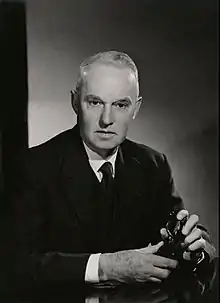Edmund Hirst
Sir Edmund Langley Hirst CBE FRS[2] FRSE (21 July 1898-29 October 1975), was a British chemist.[3]
Edmund Hirst | |
|---|---|
 Sir Edmund Langley Hirst, FRS © National Portrait Gallery, London | |
| Born | Edmund Langley Hirst 21 July 1898 |
| Died | 29 October 1975 (aged 77)[1] |
| Alma mater | University of St Andrews |
| Spouse(s) | Beda Winifred Phoebe Ramsay Kathleen (Kay) Jenny Harrison |
| Awards | Davy Medal (1948) Fellow of the Royal Society[2] |
| Scientific career | |
| Institutions | University of Edinburgh |
Life
Hirst was born in Preston, Lancashire on 21 July 1898 the son of Elizabeth (née Langley) and Rev Sim Hirst (1856-1923) a Baptist minister. He was educated in Burnley, Northgate Grammar School, Ipswich, Madras College in St Andrews, then studied chemistry at the University of St Andrews with a Carnegie Scholarship.
In World War I he was conscripted in 1917, and persuaded the authorities to return him to the University of St Andrews to study mustard gas. For the final year he served with the Special Brigade of the Royal Engineers in France. Returning to University in February 1919 he then obtained his BSc, followed by a doctorate (PhD) in 1921. In 1923 he began lecturing the University of Manchester and in 1924 went to the Armstrong College in Newcastle-upon-Tyne. Here he assisted Norman Haworth in 1934 when he became the first to synthesize Vitamin C.
In 1947 he moved to the University of Edinburgh, and in 1948 was elected a Fellow of the Royal Society of Edinburgh. His proposers were James Pickering Kendall, Edmund Percival, Thomas Robert Bolam and David Bain. He served as the Society's Vice President from 1958 to 1959 and President from 1959 to 1964. He won the Gunning Victoria Jubilee Prize for 1960-64.[4]
He held the Forbes Chair of Organic Chemistry at the University of Edinburgh and was head of department there from 1959 to 1968. He was knighted in 1964.
Hirst received an Honorary Doctorate from Heriot-Watt University in 1968.[5]
In 1973, Hirst developed Hodgkin’s disease, and his health gradually deteriorated until his death in Edinburgh on 29th October, 1975.[6]
Research
Hirst’s researches were extensive and resulted in over 260 publications. He and his co-workers determined the structure of all the known mono-, di-, oligo- and polysaccharides; and worked on the composition and structures of fructans, starches and glycogens, hemicelluloses, seaweed mucilages, and of exudate gums and related polysaccharides. In addition they synthesised authentic mono-, di- and tri-methyl ethers of arabinose, xylose, fucose, fructose, mannuronic, galacturonic and glucuronic acids.[2] Their contributions to carbohydrate chemistry were profound.
Family
He married twice. In 1925 he married Beda Winifred Phoebe Ramsay. She was hospitalised due to mental illness in 1937. The marriage was dissolved in 1948, and Beda died in Glasgow in 1962. Hirst remarried the following year, to Kathleen (Kay) Jenny Harrison. He had no children by either marriage.
References
- Stacey, Maurice (2004). "Hirst, Sir Edmund Langley (1898–1975)". The Oxford Dictionary of National Biography. doi:10.1093/ref:odnb/31238.
- Stacey, M.; Percival, E. (1976). "Edmund Langley Hirst 21 July 1898 -- 29 October 1975". Biographical Memoirs of Fellows of the Royal Society. 22: 136. doi:10.1098/rsbm.1976.0006.
- Records of the Department of Chemistry Archived 23 February 2007 at the Wayback Machine University of Edinburgh. Accessed March 2007
- Biographical Index of Former Fellows of the Royal Society of Edinburgh 1783–2002 (PDF). The Royal Society of Edinburgh. July 2006. ISBN 0 902 198 84 X.
- webperson@hw.ac.uk. "Heriot-Watt University Edinburgh: Honorary Graduates". www1.hw.ac.uk. Retrieved 11 April 2016.
- Stacey, Maurice; Manners, David J (1978). "Obituary - Edmund Langley Hirst (1898-1975)". Advances in Carbohydrate Chemistry and Biochemistry. Academic Press. 35: 1–16.